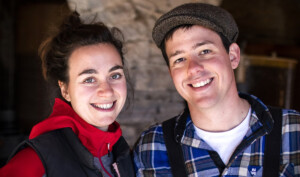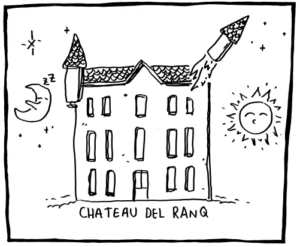Chateau del Ranq

Laure Barthelemy et Sébastien Freychet
About
Owners & winemakers: Laure Barthelemy & Sébastien Freychet
Vineyards: 14ha, all part of the family estate
Vineyard management: Biodynamic
Soils: Clay-limestone, with red stones in some parcels
Grapes grown: Primarily Syrah, Grenache, Mourvèdre, Cinsault, and Sauvignon, plus small quantities of Grenache Gris, Carignan Blanc, Savagnin, Aligoté, Bourboulenc, Pinot Gris, Sylvaner, Soreli, Malvasia, and Albarigno
Annual production: 35,000 bottles
Quick facts:
- Chateau del Ranq has been in Seb’s family since the 1200s, and it’s always been passed down from woman to woman.
- Laure and Seb’s goal is to make wines that reflect the terroir with freshness, salinity, and finesse.
- “We’re both passionate about gastronomy and wine, having been immersed in it since childhood, so it was obvious to us to make our career out of this passion. We met while studying oenology and fell in love during an animated debate about natural wine.” – Laure Barthelemy & Sébastien Freychet
Chateau del Ranq is the family estate of Sébastien Freychet’s mother–it’s been passed down through his family from woman to woman since the 1200s. Historically, the property was worked by tenant farmers, but starting in 2019, Sébastian and his wife Laure Barthelemy became the first members of the family to farm the vineyards and make their own wine. Seb grew up in the area, and while his family wasn’t making wine at the estate at the time, he spent his childhood on a tractor with his father, who managed a domaine in Sommière. He therefore chose to pursue studies in oenology, which took him to Burgundy, where he worked at a number of domaines including Alice and Olivier De Moor and Xavier Bruguière. Laure, originally from Burgundy, took the same oenology courses as Seb–where they crossed paths and fell in love–and spent time working with François Carillon in Puligny and Jean Marc Boillot in Pommard. “We’re both passionate about gastronomy and wine, having been immersed in it since childhood, so it was obvious to us to make our career out of this passion,” Laure explains.
The estate is found in the northern part of the Pic St Loup appellation, close to the Cevennes mountain range. “It’s a challenge to make fresh wines in the south, but it’s possible!” Laure tells us. It’s a slightly cooler terroir, which, along with the predominantly limestone soils, helps them achieve their goal of making wines that are digeste and fruit-forward. Even in a slightly cooler microclimate, the region is undoubtedly southern, so intense heat is still a regular concern. They mitigate the effects of the heat with grass cover and green manures in the vineyard. This allows the soil to retain water better, so the vines are more resilient. Choosing the exact right moment to harvest is also key. Laure and Seb regularly go for walks through the vineyards, tasting grapes, and when they find that the balance of sugar, acid, and flavor is just right, they decide to pick. This often means that they’re making the decision the night before to harvest the following morning. “Observing the nature that surrounds us, feeling the energy, that’s what guides us in all of our decisions,” Laure explains. “And that’s not something we learned during our studies, it’s a sensibility that has grown within us thanks to the time spent in our vineyards.”
In the cellar, Laure and Seb work with minimal intervention. The goal is a gentle and natural extraction, with fairly short macerations and only one light daily pumpover. All fermentations take place with indigenous yeast. The cuvées intended for longer aging see an extended élevage in large old foudres, while others are rested for a short time in tank. The resulting wines have a profile of salinity, finesse, and freshness above all.

